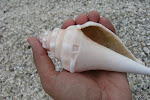I noticed some cord laying around that I rolled together while I was on Managaha Island two weeks ago. I was invited by the SDA School to do outdoor classes and I decided to do a nature walk with the younger kids to talk about plants and natural history. At the end of the walk, I picked up a dried screwpine (Pandanus tectorius) leaf, ripped off the spines and started thigh-twisting the strands to cordage. The Chamorros name for this particular screw pine is pahong. I was surprised how tough the cord was after I rolled it. Here's a post with a tutorial on how to make cordage.
 I also had a giant clam (Tridacna maxima) bead I took off from a necklace about a year ago that was just lying around unused. I decided to take it off of the nylon cord I had originally used and make a more natural piece. The Chamorro word for giant clam is hima and they called the shell money/ornamental beads, salape'.
I also had a giant clam (Tridacna maxima) bead I took off from a necklace about a year ago that was just lying around unused. I decided to take it off of the nylon cord I had originally used and make a more natural piece. The Chamorro word for giant clam is hima and they called the shell money/ornamental beads, salape'. Hima is very difficult to cut and carve since its calcite-aragonite matrix is very hard, finely-packed and so crystal-like that it cracks easily when it gets heated. Here is the finished piece.
Hima is very difficult to cut and carve since its calcite-aragonite matrix is very hard, finely-packed and so crystal-like that it cracks easily when it gets heated. Here is the finished piece. I had a few extra strands of the leaf to roll a smaller cord for the salape' attachment. It is pretty tiring to roll the tiny cord with your fingers.
I had a few extra strands of the leaf to roll a smaller cord for the salape' attachment. It is pretty tiring to roll the tiny cord with your fingers. I still need a lot of help with my technique. Can you see where I cheated? It's my secret.
I still need a lot of help with my technique. Can you see where I cheated? It's my secret.
Sadly, I did not have enough of the pahong leaf to use on the loop, and had to resort to using black nylon cordage. Here is a simple loop and knot for the necklace clasp.
 Voila'. It's done.
Voila'. It's done.
 Well, I am glad of the finished product since it is mostly all natural materials. I need more practice to really get the binding of these things done well. Come to think of it, I haven't had a lot of time lately to make any more necklaces.
Well, I am glad of the finished product since it is mostly all natural materials. I need more practice to really get the binding of these things done well. Come to think of it, I haven't had a lot of time lately to make any more necklaces. I did accomplish to get sleepy after everything was done so the project suited me well for the time it took.
I did accomplish to get sleepy after everything was done so the project suited me well for the time it took.Ti napu.
The Beachcomber.
PS. Oops! I misnamed the leaf that I used. There are two types of native screwpines in the Marianas: Pandanus tectorius which the natives call kafu' and Pandanus dubious which is locally called pahong. I have a picture of both in this entry. Check them out in the Guam Forestry website.


4 comments:
Very nice! I think it's awesome that you crafted the cord too!
It's so beautiful!!! I love it!
Drea- Thanks! I find that the binding/cording in making these the hardest to learn (esp. when no one has time to teach you how to do it..hehe).
Mai- I haven't thanked you for posting pics of Tali from your OR visits. I see her wearing the one I gave her for her baptism and she just emailed me saying that she still wears it often. <3 you!
Hey, BC look us up next week. We'll be in Saipan from April 2 to April 10 or 11. We'll be staying at the compound.
Post a Comment